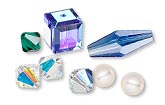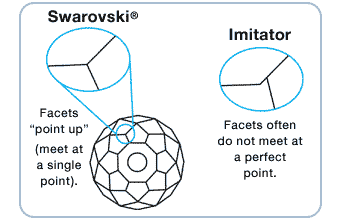Swarovski crystals are one of my favorite elements to use in my jewelry designs. I use them in almost everything I make because they add such a lustrous sparkle. I came across this article about swarovski crystals - their quality and how to ensure that you are actually getting the "real deal" and thought I would share it with you - Enjoy!!
Swarovski® - How to Ensure You are Getting the Real Thing
Swarovski (Swore-off-ski) crystal components are regarded as the highest quality machine cut and polished crystal beads in the world. The demand for luxury products unfortunately can create a host of imitators. The imitators are all over the Internet and at every bead show that we have visited.
The Swarovski company creates its glass with a special compound that imitators cannot duplicate. This special compound creates the incredible brilliance of their product. The delicate color palette is another quality that sets Swarovski crystal components apart from others.
With so many crystal beads and components out there, how can you tell if the crystal you are purchasing is actually a Swarovski crystal component....or an imitation?
Here are some tips that can help you determine which crystals are genuine:
- Swarovski crystals are generally not strung when offered for sale.
- Look for the original Swarovski packaging. Dependant on size, the bulk packages will range from 10 gross to 1/2 gross, in well-branded, sealed envelopes. The newest Swarovski bulk packaging is sealed with an authenticated silver toned hologram saying "SWAROVSKI ELEMENTS."
- Swarovski crystals are perfectly uniform. Since they are machine cut, each crystal is the same. This means that the height, width and slope are consistent. A hand polished imitator bead will not have as uniform a cut. You may also notice different dimensions from bead to bead.
- Swarovski uses machinery that precisely cuts each crystal. According to Swarovski, "cutting hard materials such as crystal and gems, in such a way that they have a hundred identical facets in several directions, is a very complicated task; each direction of the reflected light must first be calculated by computer, then this has to be simulated in 3D, optimized and finally converted into control programs for complex machinery." This is just part of the technology that gives Swarovski crystals their unbelievable flash.
- The precision cutting of Swarovski machinery allows each crystal to have its facet juncture "pointing up". This means the facet junctures all meet at precisely the same point. This is a similar aspect of diamond faceting. See the illustration above.
- AB finish Swarovski crystals have a uniform surface luster. There are no swirling marks from the vacuum process that produces the AB finish, and generally there are no scratches. The "imitations" often have scratches, swirl marks ("oily" looking surface). Some of these imperfections, in the "imposters", have to do with the lower quality of the finish. See the illustration above.
- When you look inside the crystal, you will see no bubbles. If you see any bubbles, you know immediately that it is a fake.
- Because of its special glass compounds, Swarovski crystal will out-sparkle a bead of lesser quality when placed in a side-by-side comparison.
 |
Your
best bet is to buy from reputable suppliers known to be Swarovski
distributors. Just because they display the logo does not mean they are
true distributors. We have seen many vendors incorrectly (and illegally)
displaying the swan logo of Swarovski when selling beads at shows.
|


Good information!
ReplyDelete